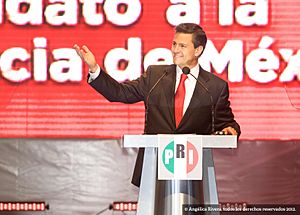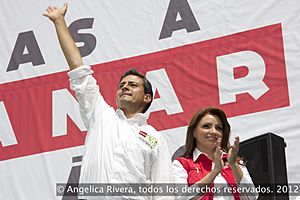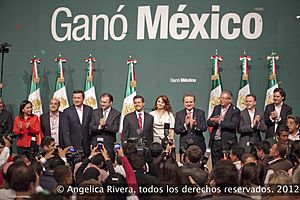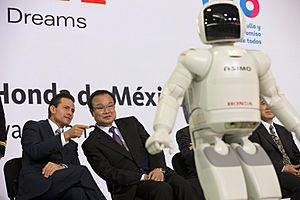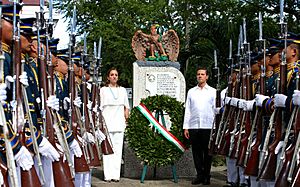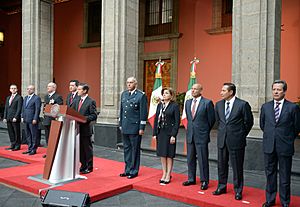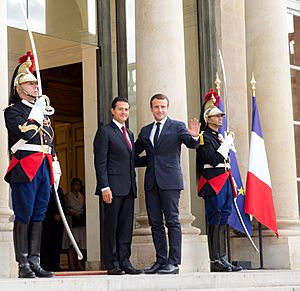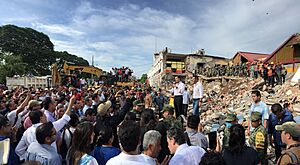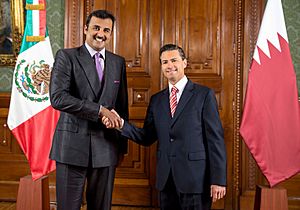Enrique Peña Nieto facts for kids
Quick facts for kids
Enrique Peña Nieto
|
|
|---|---|
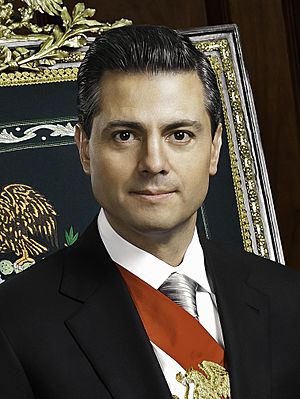
Official portrait, 2012
|
|
| 64th President of Mexico | |
| In office 1 December 2012 – 30 November 2018 |
|
| Preceded by | Felipe Calderón |
| Succeeded by | Andrés Manuel López Obrador |
| President pro tempore of the Pacific Alliance |
|
| In office 20 June 2014 – 3 July 2015 |
|
| Preceded by | Juan Manuel Santos |
| Succeeded by | Ollanta Humala |
| Governor of the State of Mexico | |
| In office 16 September 2005 – 15 September 2011 |
|
| Preceded by | Arturo Montiel Rojas |
| Succeeded by | Eruviel Ávila Villegas |
| Member of the Congress of the State of Mexico from the 13th district |
|
| In office 5 September 2003 – 14 January 2005 |
|
| Preceded by | Arturo Osornio Sánchez |
| Succeeded by | Jesús Alcántara Núñez |
| Secretary of Administration of the State of Mexico | |
| In office 11 May 2000 – 4 December 2002 |
|
| Governor | Arturo Montiel Rojas |
| Preceded by | Ernesto Nemer Álvarez |
| Succeeded by | Luis Miranda Nava |
| Personal details | |
| Born |
Enrique Peña Nieto
20 July 1966 Atlacomulco, State of Mexico, Mexico |
| Political party | Institutional Revolutionary Party |
| Spouses | |
| Children | 4 |
| Parents | Gilberto Enrique Peña del Mazo María Socorro Nieto Sánchez |
| Education | Panamerican University (LLB) Monterrey Institute of Technology and Higher Education (MBA) |
| Signature |  |
Enrique Peña Nieto (born 20 July 1966) is a Mexican former politician and lawyer. He served as the 64th president of Mexico from 2012 to 2018. He is a member of the Institutional Revolutionary Party (PRI). Before becoming president, he was the Governor of the State of Mexico from 2005 to 2011.
Born in Atlacomulco and raised in Toluca, Peña Nieto studied law at Panamerican University. He later earned a master's degree in business from ITESM. He joined the PRI political party in 1984 and began his political career. He became governor of the State of Mexico in 2005. As governor, he made many promises to improve the state.
During his time as president, Peña Nieto introduced several important changes. These included reforms to the economy and education system. However, his presidency also faced challenges, including public criticism and concerns about corruption. His approval ratings were low by the end of his term.
Contents
Early Life and Education
Enrique Peña Nieto was born on 20 July 1966 in Atlacomulco, State of Mexico. This city is about 88 kilometers northwest of Mexico City. He is the oldest of four children. His father, Gilberto Enrique Peña del Mazo, was an electrical engineer. His mother, María del Perpetuo Socorro Ofelia Nieto Sánchez, was a schoolteacher.
When he was 15, Peña Nieto helped with his relative Alfredo del Mazo González's political campaign. This experience sparked his interest in politics. In 1985, at age 18, he moved to Mexico City to study law at Panamerican University. He later earned a Master of Business Administration (MBA) degree.
Political Beginnings
Peña Nieto joined the Institutional Revolutionary Party (PRI) in 1984. He started his political career working for Arturo Montiel Rojas, who was a governor of the State of Mexico and his uncle. Peña Nieto held several positions in the state government. These roles helped him build relationships with important politicians and business leaders.
Campaign for Governor
In 2003, Peña Nieto was elected as a local representative for his hometown of Atlacomulco. In 2005, he ran for governor of the State of Mexico. He won the election and became governor. On 12 February 2005, he was officially named the PRI candidate.
Governor of the State of Mexico (2005–2011)
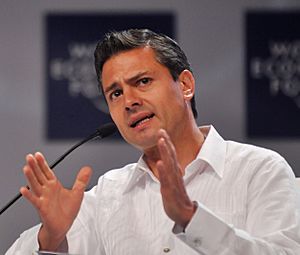
Peña Nieto became governor of the State of Mexico on 15 September 2005. His main goal as governor was to fulfill 608 promises he made during his campaign. These promises included building highways, hospitals, and improving water systems.
Many projects were completed during his term. Highway infrastructure greatly improved. New public transportation systems like the "Mexibús" were built, helping many commuters. Health services also expanded, with new hospitals and medical centers. The state's finances were managed to keep debt from growing.
However, his time as governor also faced criticism. There were concerns about crime rates. He also faced criticism regarding how his administration handled protests in San Salvador Atenco.
Presidential Campaign
On 23 November 2011, Peña Nieto presented his book México, la gran esperanza (Mexico, the great hope). In the book, he discussed ways to grow Mexico's economy and create more jobs. He also suggested that Pemex, Mexico's state-owned oil company, should be more competitive.
On 27 November 2011, Peña Nieto became the PRI's official candidate for the 2012 Mexican presidential elections. During his campaign, he faced some public questions. For example, he struggled to name three books that had influenced his life. He also admitted he didn't know the price of tortillas, which led to some criticism.
Elections
The presidential election took place on 1 July 2012. Initial results showed Peña Nieto leading with 38% of the votes. His closest opponent was Andrés Manuel López Obrador. Peña Nieto declared victory, promising a responsible government. The PRI won the election, but López Obrador challenged the results, claiming issues with the voting process.
Presidency (2012–2018)
Enrique Peña Nieto became President of Mexico on 1 December 2012. During his inauguration, he outlined his plans for the country. Protests occurred outside the National Palace, leading to clashes with police. The day after his inauguration, Peña Nieto signed the Pact for Mexico. This agreement aimed to help the major political parties work together on national goals. He left office on 1 December 2018, and Andrés Manuel López Obrador became the new president.
Economic Policy
Under Peña Nieto's presidency, Mexico's auto manufacturing industry grew quickly. Many international car companies invested billions of dollars to build factories in Mexico. This led to a significant increase in jobs.
His administration also focused on creating more jobs across different sectors. Between 2012 and 2016, over two million jobs were created in Mexico. These new jobs helped increase revenue for social security programs.
Special Economic Zones
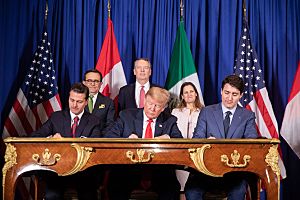
In May 2016, Peña Nieto signed a law to create special economic zones in poorer southern states. These zones were designed to attract businesses and create jobs in areas that needed more development. They offered tax benefits and aimed to boost investment. The goal was to reduce poverty and help these regions catch up with the more industrialized parts of Mexico.
Domestic Policy
Peña Nieto introduced a major public education reform. This reform aimed to improve teaching standards and reduce corruption within the education system. It sought to centralize how teachers were hired and evaluated.
Security Policy
Peña Nieto's security policy focused on reducing violence, such as murders, kidnappings, and extortions. This was a shift from previous strategies that mainly targeted drug organizations. He proposed creating a national police force called a "gendarmerie." The government also formed specialized police units to handle major crimes.
Energy Policy

Peña Nieto aimed to allow private investment in Pemex, Mexico's state-owned oil company. This was a significant change, as the Mexican constitution had previously limited outside investment in the oil sector. The goal was to encourage more exploration and development. However, this policy led to protests across the country due to rising gasoline prices.
Foreign Policy
2016 Visit by Donald Trump
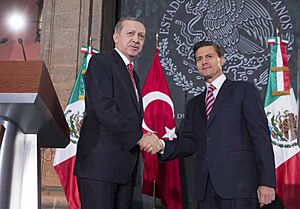

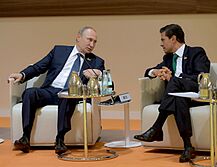
In August 2016, Peña Nieto invited then-U.S. presidential candidate Donald Trump to visit Mexico. They held a press conference together. Peña Nieto faced criticism for this invitation. He stated on Twitter that he made it clear to Trump that Mexico would not pay for a border wall.
Trump's Presidency and Border Wall
A planned meeting between Peña Nieto and President Trump in January 2017 was canceled. This happened after Trump stated that if Mexico would not pay for a border wall, it would be better to cancel the meeting. Peña Nieto then canceled his visit.
Controversies
Publicity and Public Image
Reports in 2017 suggested that Enrique Peña Nieto's government spent a large amount of money on publicity. There were also claims of social media manipulation, with automated accounts (sometimes called "Peñabots") supporting the government.
Iguala Mass Kidnapping
In September 2014, 43 college students disappeared in Guerrero. This event became a major public security issue during Peña Nieto's presidency. It led to widespread protests and international concern.
Freedom of the Press
During his term, there were concerns about the safety of journalists in Mexico. The country was seen as one of the most dangerous places for journalists. There were also accusations that the government used surveillance tools against reporters and activists.
A notable incident involved journalist Carmen Aristegui. She reported on a house owned by Peña Nieto's wife, Angélica Rivera, which was linked to a company that received government contracts. This raised questions about potential conflicts of interest. Aristegui was later fired from her radio show, which many saw as an act of censorship.
Allegations of Corruption
Peña Nieto's administration faced many allegations of corruption. Several former governors from his party were investigated. There were also claims that his government tried to block investigations into public corruption.
One major controversy involved the Brazilian company Odebrecht. There were allegations that Peña Nieto's presidential campaign received illegal funds from Odebrecht in exchange for government contracts. These claims led to investigations and public debate.
Personal Life
Family Life
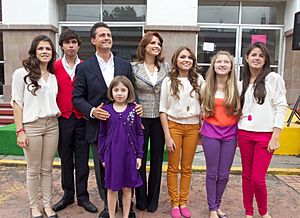
In 1993, Peña Nieto married Mónica Pretelini. They had three children. Mónica passed away in 2007. In 2008, Peña Nieto began a relationship with actress Angélica Rivera, and they married in November 2010. They divorced in 2019.
Peña Nieto is related to several important political figures in the State of Mexico. His cousin, Alfredo del Mazo Maza, also served as governor of the State of Mexico from 2017 to 2023.
Honors
Enrique Peña Nieto received many honors during his career, both from Mexico and other countries.
National Honors
 : Collar of the Order of the Aztec Eagle (1 December 2012)
: Collar of the Order of the Aztec Eagle (1 December 2012)
Foreign Honors
 National Order of Juan Mora Fernández, Grand Cross with Gold Plaque, awarded by Laura Chinchilla on 19 February 2013.
National Order of Juan Mora Fernández, Grand Cross with Gold Plaque, awarded by Laura Chinchilla on 19 February 2013. National Order of the Legion of Honour, Grand Cross, awarded by Francois Hollande on 10 April 2014.
National Order of the Legion of Honour, Grand Cross, awarded by Francois Hollande on 10 April 2014. Order of Prince Henry, Grand Collar, awarded by Aníbal Cavaco Silva on 2 June 2014.
Order of Prince Henry, Grand Collar, awarded by Aníbal Cavaco Silva on 2 June 2014. Order of Isabella the Catholic, Grand Cross with Collar, awarded by King Juan Carlos I of Spain on 6 June 2014.
Order of Isabella the Catholic, Grand Cross with Collar, awarded by King Juan Carlos I of Spain on 6 June 2014. Order of the Sun of Peru, Grand Cross with Diamonds, awarded by Ollanta Humala on 17 July 2014.
Order of the Sun of Peru, Grand Cross with Diamonds, awarded by Ollanta Humala on 17 July 2014. Order of the Bath, Honorary Knight Grand Cross, awarded by Queen Elizabeth II of the United Kingdom on 3 March 2015.
Order of the Bath, Honorary Knight Grand Cross, awarded by Queen Elizabeth II of the United Kingdom on 3 March 2015. Order of the Quetzal, Grand Collar, awarded by Otto Pérez Molina on 13 March 2015.
Order of the Quetzal, Grand Collar, awarded by Otto Pérez Molina on 13 March 2015. Order of the Southern Cross, Grand Collar, awarded by Dilma Rousseff on 26 May 2015.
Order of the Southern Cross, Grand Collar, awarded by Dilma Rousseff on 26 May 2015. Order of Charles III, Grand Cross with Collar, awarded by King Felipe VI of Spain on 20 June 2015.
Order of Charles III, Grand Cross with Collar, awarded by King Felipe VI of Spain on 20 June 2015. Order of the White Rose of Finland, Grand Cross with Collar, awarded by Sauli Niinistö on 25 May 2015.
Order of the White Rose of Finland, Grand Cross with Collar, awarded by Sauli Niinistö on 25 May 2015. Order of Merit, Grand Collar, awarded by Michelle Bachelet on 13 August 2015.
Order of Merit, Grand Collar, awarded by Michelle Bachelet on 13 August 2015. Order of King Abdulaziz, Collar, awarded by King Salman of Saudi Arabia on 17 January 2016.
Order of King Abdulaziz, Collar, awarded by King Salman of Saudi Arabia on 17 January 2016. Order of Mubarak the Great, Collar, awarded by Emir Sabah Al-Ahmad Al-Jaber Al-Sabah on 20 January 2016.
Order of Mubarak the Great, Collar, awarded by Emir Sabah Al-Ahmad Al-Jaber Al-Sabah on 20 January 2016. Order of the Elephant, Knight, awarded by Queen Margrethe II of Denmark on 13 April 2016.
Order of the Elephant, Knight, awarded by Queen Margrethe II of Denmark on 13 April 2016. Order of Merit of the Italian Republic, Grand Cross with Cordon, awarded by Sergio Mattarella on 21 July 2016.
Order of Merit of the Italian Republic, Grand Cross with Cordon, awarded by Sergio Mattarella on 21 July 2016. Order of the Liberator General San Martín, Grand Collar, awarded by Mauricio Macri on 29 July 2016.
Order of the Liberator General San Martín, Grand Collar, awarded by Mauricio Macri on 29 July 2016. Military Order of Saint James of the Sword, Grand Collar awarded by Marcelo Rebelo de Sousa on 17 July 2017.
Military Order of Saint James of the Sword, Grand Collar awarded by Marcelo Rebelo de Sousa on 17 July 2017. Medal of the Oriental Republic of Uruguay on 9 February 2018.
Medal of the Oriental Republic of Uruguay on 9 February 2018.
See also
- 2015 Mexican legislative election
- 2012 Mexican general election
- 2005 State of Mexico election
- Peñabot


